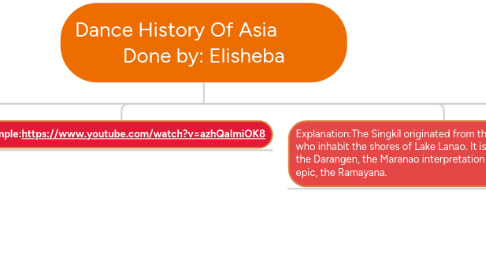
1. 2
1.1. Multidisciplinarism
1.1.1. Explanation:is a genre of dance drama from Thailand. It is traditionally performed solely in the royal court, by men in masks accompanied by narrators and a traditional piphat ensemble. A variation of this genre with female performers is called khon phu ying (โขนผู้หญิง). In Cambodia, the analog of the Khon is a less refined version known as Lakhon khol.
1.1.2. Example: Khon https://www.youtube.com/watch?v=-OWBs48qUuA
1.2. Intercultralism
1.2.1. Explanation: Country of origin was India. Hand Gestures are similar to Indian dance however it has a different meaning.
1.2.2. Example: Ramakien https://www.youtube.com/watch?v=UFQ3AACULB4
1.3. Ritualism
1.3.1. Explanation: The nantha-peri is a drum characteristic of the northern region of Thailand, which is used for two purposes: to spur on warriors prior to battle and to pay homage to the Buddha in religious ceremonies.
1.3.2. Example: Dance of the Nantha-Peri and Pu-Cha Drums
1.4. Storytelling
1.4.1. Explanation: The Ramakien (รามเกียรติ์, "Glory of Rama", sometimes also spelled Ramakian) is Thailand's national epic, derived from the Hindu epic Ramayana.
1.4.2. Example: Ramakien https://www.youtube.com/watch?v=UFQ3AACULB4
2. 1
2.1. Country Of Origin: Myanmar
2.2. Multidisciplinarism
2.2.1. Explanation: It uses two disciplinary. Dance and Puppetry
2.2.2. Example: Burmese Classical dance https://www.youtube.com/watch?v=08kvM2z2JbI
2.3. Intercultralism
2.3.1. Explanation: the dance has indian influences. for example, the hand gestures and feet movements are similar
2.3.2. Example
2.4. Ritualism
2.4.1. Explanation:In Burma, it is traditional to make an offering of a green coconut, three hands of bananas, and a few other accessories, to the Guardian Spirit of Land (a nat) prior to an important event such as an inauguration. This appeasement of the Spirit is usually done by a professional Spirit Medium (Nakadaw). The dancer is often attired in red silk, including a red headband and, around the chest, and a tightly knotted red scarf. With the offerings on a tray, she or he dances in propitiation and repeats the sequence three times. As medium dances she sings ritual songs to the 37 National Nats (Spirits) and the Local Nat. At the onset, the dance is delicate and the music legato. After a verbal injunction, the dancer quickens to the rising intensity of the music. As the Medium enjoins the Spirits, the movements and the music reach a frenzied crescendo.
2.4.2. Example: Nat Dance https://www.youtube.com/watch?v=ywuhWi3j0Fg&gl=SG&hl=en-GB
2.5. Storytelling
2.5.1. Explanation: It is the Burmese version of the Ramanyana epic
2.5.2. Example: Yama Zatdaw https://www.youtube.com/watch?v=j9ccQD48pcw
3. 4
3.1. Country Of Origin: Indonesia
3.2. Multidisciplinarism
3.2.1. Explanation: Dance and Puppetry.Wayang wong, also known as Wayang orang (literally 'human wayang)', is a type of classical Javanese dance theatrical performance with themes taken from episodes of the Ramayana or Mahabharata.
3.2.2. Example: Wanyang Wong
3.3. Intercultralism
3.3.1. Example: Wanyang Wong
3.4. Ritualism
3.4.1. Explanation : the Kecak dance depicts the Hindu epic, “Ramayana,” that tells the story of Prince Rama, who with the help of the monkey-like Vanara defeats the evil King Ravana to rescue his Princess Sita. Kecak also has roots in Sanghyang, a sacred ritual based on the idea that during the performance, hyangs, or spiritual entities will enter and possess the bodies of the dancers.
3.4.2. Example: Kechak (Bali, Indonesia) https://www.youtube.com/watch?v=2WHx2ITKtUg
3.5. Storytelling
3.5.1. Explanation: Kakawin Ramayana is an Old Javanese rendering of the Sanskrit Ramayana in kakawin meter.
3.5.2. Example: Kakawin Ramayana
4. 3
4.1. Country Of Origin: Philippines
4.2. Multidisciplinarism
4.2.1. Explanation: Dance and Music
4.3. Intercultralism
4.3.1. Explanation: Spanish dance influence. Costumes are similar, uses almost the same instruments for the dance however the instruments are made out of different materials.
4.4. Ritualism
4.4.1. Explanation: Performed every 13th moon by the people who live in the foothills of Mount Apo, Bagoboo. The purpose is to renew their vows to the Harvest God, Magababaya. Also it is a rite of passage for the young sons of datu
4.4.2. Example: Gin-Um http://archives.starbulletin.com/2006/03/17/features/art3d.jpg
4.5. Storytelling
4.5.1. Example: Singkíl https://www.youtube.com/watch?v=_qG0bjUxWAk&hl=en-GB&gl=SG
